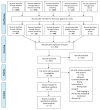Milk Fat Globule Membrane Supplementation in Children: Systematic Review with Meta-Analysis
- PMID: 33668227
- PMCID: PMC7996302
- DOI: 10.3390/nu13030714
Milk Fat Globule Membrane Supplementation in Children: Systematic Review with Meta-Analysis
Abstract
(1) Background: Milk fat globule membrane (MFGM), composing fat droplets responsible for lipid transport in breast milk, has been shown to possess immunological and antimicrobial effects. Standard formulas (SF) are devoid of MFGMs during the production process. The study's aim was to evaluate the safety and benefits of MFGMs supplementation in children. (2) Methods: We searched four databases for randomized controlled trials evaluating the supplementation of MFGMs in children. Growth parameters were chosen as the primary outcome. (3) Results: Twenty-four publications of seventeen studies were included. Meta-analyses assessing the primary outcomes at the age of 4 months included four studies (814 children) comparing the MFGM-supplemented formulas and SF, and two trials (549 children) comparing the MFGM-supplemented formulas and breastfeeding. The primary outcomes were non-inferior in all the experimental MFGM formulas compared to SF, or even represented more similar results to breastfed infants. The promising effects, including a lower incidence of acute otitis media and improved cognitive development, cannot be firmly confirmed due to the small amount of existing evidence. No significant adverse effects were reported in any of the assessed products. (4) Conclusions: The available data signaled beneficial effects and a good safety profile, requiring future research with well-designed trials.
Keywords: MFGM; children; feeding; infant formula; milk fat globule membrane.
Conflict of interest statement
The authors declare no conflict of interest.
Figures



Similar articles
-
Supplementation of Infant Formula with Bovine Milk Fat Globule Membranes.Adv Nutr. 2017 Mar 15;8(2):351-355. doi: 10.3945/an.116.014142. Print 2017 Mar. Adv Nutr. 2017. PMID: 28298277 Free PMC article. Review.
-
Infant formula supplemented with milk fat globule membrane compared with standard infant formula for the cognitive development of healthy term-born formula-fed infants: protocol for a randomised controlled trial.BMJ Open. 2024 Jul 1;14(6):e083399. doi: 10.1136/bmjopen-2023-083399. BMJ Open. 2024. PMID: 38951000 Free PMC article.
-
Bovine Milk Fat Globule Membrane Supplementation and Neurocognitive Development: A Systematic Review and Meta-Analysis.Nutrients. 2024 Jul 22;16(14):2374. doi: 10.3390/nu16142374. Nutrients. 2024. PMID: 39064816 Free PMC article.
-
Physiological Effects of Feeding Infants and Young Children Formula Supplemented with Milk Fat Globule Membranes.Nestle Nutr Inst Workshop Ser. 2019;90:35-42. doi: 10.1159/000490291. Epub 2019 Mar 13. Nestle Nutr Inst Workshop Ser. 2019. PMID: 30865975
-
Safety and tolerance assessment of milk fat globule membrane-enriched infant formulas in healthy term Chinese infants: a randomised multicenter controlled trial.BMC Pediatr. 2022 Aug 3;22(1):465. doi: 10.1186/s12887-022-03507-8. BMC Pediatr. 2022. PMID: 35918695 Free PMC article. Clinical Trial.
Cited by
-
The Immunological Role of Milk Fat Globule Membrane.Nutrients. 2022 Oct 31;14(21):4574. doi: 10.3390/nu14214574. Nutrients. 2022. PMID: 36364836 Free PMC article. Review.
-
Impact of a Nutrient Formulation on Longitudinal Myelination, Cognition, and Behavior from Birth to 2 Years: A Randomized Clinical Trial.Nutrients. 2023 Oct 19;15(20):4439. doi: 10.3390/nu15204439. Nutrients. 2023. PMID: 37892514 Free PMC article. Clinical Trial.
-
Beyond ingredients: Supramolecular structure of lipid droplets in infant formula affects metabolic and brain function in mouse models.PLoS One. 2023 Aug 2;18(8):e0282816. doi: 10.1371/journal.pone.0282816. eCollection 2023. PLoS One. 2023. PMID: 37531323 Free PMC article.
-
Determination of the Fatty Acid Profile and Lipid Quality Indices in Selected Infant Formulas.Molecules. 2024 Apr 29;29(9):2044. doi: 10.3390/molecules29092044. Molecules. 2024. PMID: 38731536 Free PMC article.
-
Roles of Milk Fat Globule Membrane on Fat Digestion and Infant Nutrition.Food Sci Anim Resour. 2022 May;42(3):351-371. doi: 10.5851/kosfa.2022.e11. Epub 2022 May 1. Food Sci Anim Resour. 2022. PMID: 35611078 Free PMC article. Review.
References
Publication types
MeSH terms
Substances
LinkOut - more resources
Full Text Sources
Other Literature Sources
Medical

